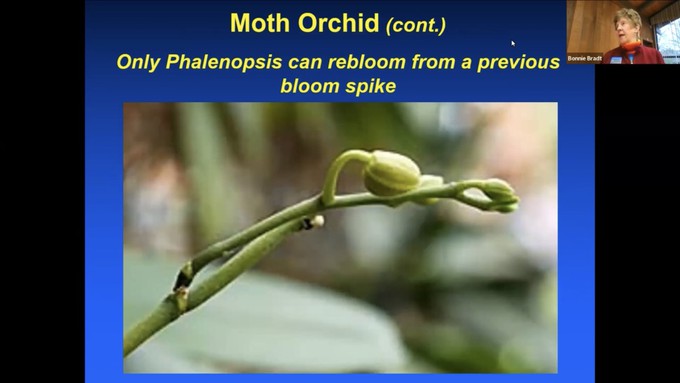
Master gardeners have many short and workshop-length films for our climate

Watch the "Orchid-Mania" Zoom workshop recorded by the Placer County master gardeners earlier this month, one of dozens of gardening videos by and available for the region's gardeners. Screenshot via Placer County master gardener YouTube channel
Oh, gee, is the garden soggy today. No point in trying to do anything but dump out water accumulated in saucers and (oops) buckets.
But frightful weather is a great excuse to stay inside and watch those garden videos you’ve been meaning to get to.
A quick warning on videos, however: If they’re filmed in Michigan, Florida or New Jersey, for example, they might include inaccurate advice for Northern California gardening, the Sacramento region specifically. After all, much of the country is under snow or ice right now, and those of us in the valley and lower foothills are not – a perfect example of why our gardening year is so different.
Conveniently, the master gardeners of Sacramento, Placer, El Dorado and Yolo counties have made many video resources available, including filming their own gardening-tip YouTube videos or past workshops. Here’s a quick summary of pertinent ones for this time of year, plus links to the various video libraries:
– Sharpening Hand Pruners. It’s pruning season, so make sure those pruners are clean and sharp. (Under 5 minutes)
– Pruning Woody Sages. This video includes summer and winter pruning; the latter is important so sages grow back beautifully and not too rangy in spring. (Under 3 minutes)
– Make Your Garden Wildlife Friendly. This dovetails (if you’ll pardon the pun) with my blog post from last week, A lively natural habitat includes birds. (9 minutes)
– Shopping for Bareroot Fruit Trees. This is a Dave Wilson Nursery video hosted on the Sacramento site. (Under 7 minutes)
– Straw Bale Gardening. Plan your straw-bale garden now with the help of this recorded workshop. (31 minutes)
– Orchid-Mania. Workshop on how to choose and care for orchids. (66 minutes)
– Full pdf list of workshop videos with links. The pdf also includes links to printable handouts associated with the workshops.
– Pruning Hybrid Roses. (Under 7 minutes)
– List of slide presentations. Done webinar-style, each about 1 hour.
– Garden Allies. Recorded workshop on critters in the garden. (1 hour 22 minutes)
– YouTube channel for UCCE Central Sierra, which includes El Dorado and Amador counties
The various master gardener groups will start up workshops and open garden days again in January, beginning at the end of next week. Be sure to check out their websites (those links on the counties’ names) for event schedules.
Comments
0 comments have been posted.Sacramento Digs Gardening to your inbox.
Food in My Back Yard Series
May 6: Maintain soil moisture with mulch for garden success
April 29: What's (already) wrong with my tomato plants?
April 22: Should you stock up on fertilizer? (Yes!)
April 15: Grow culinary herbs in containers
April 8: When to plant summer vegetables
April 1: Don't be fooled by these garden myths
March 25: Fertilizer tips: How to 'feed' your vegetables for healthy growth
March 18: Time to give vegetable seedlings some more space
March 11: Ways to win the fight against weeds
March 4: Potatoes from the garden
Feb. 25: Plant a fruit tree now -- for later
Feb. 18: How to squeeze more food into less space
Feb. 11: When to plant? Consider staggering your transplants
Feb. 4: Starting in seed starting
Sites We Like
Garden Checklist for week of May 11
Make the most of the lower temperatures early in the week. We’ll be back in the 80s by Thursday.
* Plant, plant, plant! It’s prime planting season in the Sacramento area. Time to set out those tomato transplants along with peppers and eggplants. Pinch off any flowers on new transplants to make them concentrate on establishing roots instead of setting premature fruit.
* Direct-seed melons, cucumbers, summer squash, corn, radishes, pumpkins and annual herbs such as basil.
* Harvest cabbage, lettuce, peas and green onions.
* In the flower garden, direct-seed sunflowers, cosmos, salvia, zinnias, marigolds, celosia and asters. (You also can transplant seedlings for many of the same flowers.)
* Plant dahlia tubers.
* Transplant petunias, marigolds and perennial flowers such as astilbe, columbine, coneflowers, coreopsis, dahlias, rudbeckia and verbena.
* Keep an eye out for slugs, snails, earwigs and aphids that want to dine on tender new growth.
* Feed summer bloomers with a balanced fertilizer.
* For continued bloom, cut off spent flowers on roses as well as other flowering plants.
* Add mulch to the garden to maintain moisture. Mulch also cuts down on weeds. But don’t let it mound around the stems or trunks of trees or shrubs. Leave about a 6-inch-to-1-foot circle to avoid crown rot or other problems.
* Remember to weed! Pull those nasties before they set seed.
* Water early in the day and keep seedlings evenly moist.